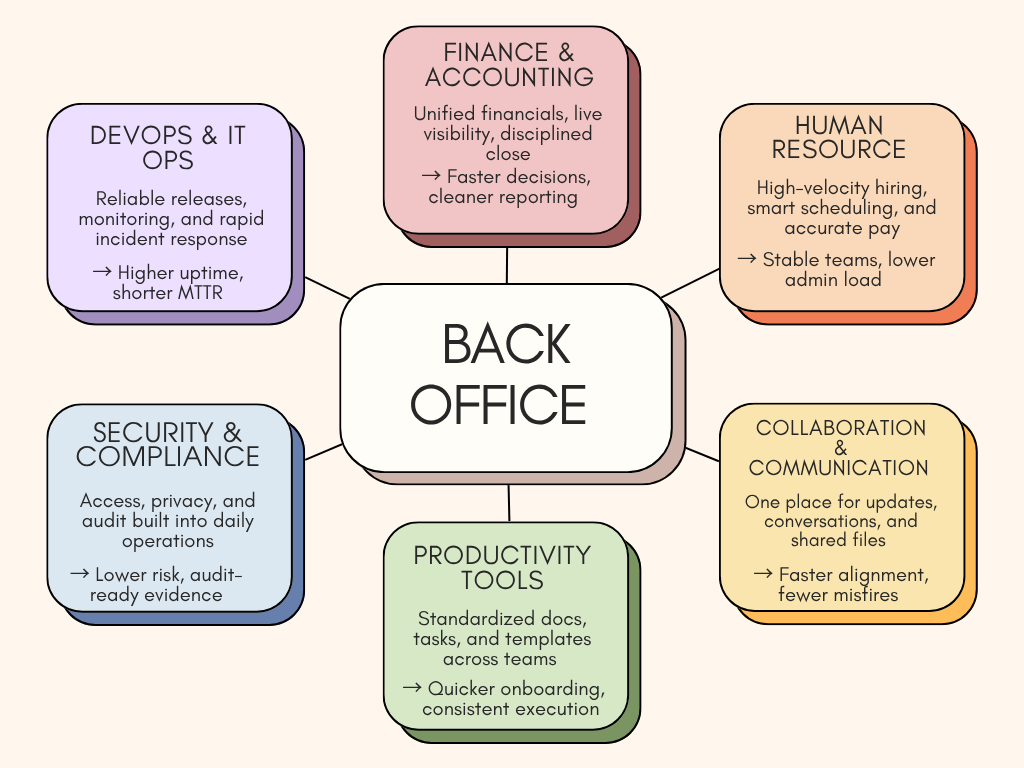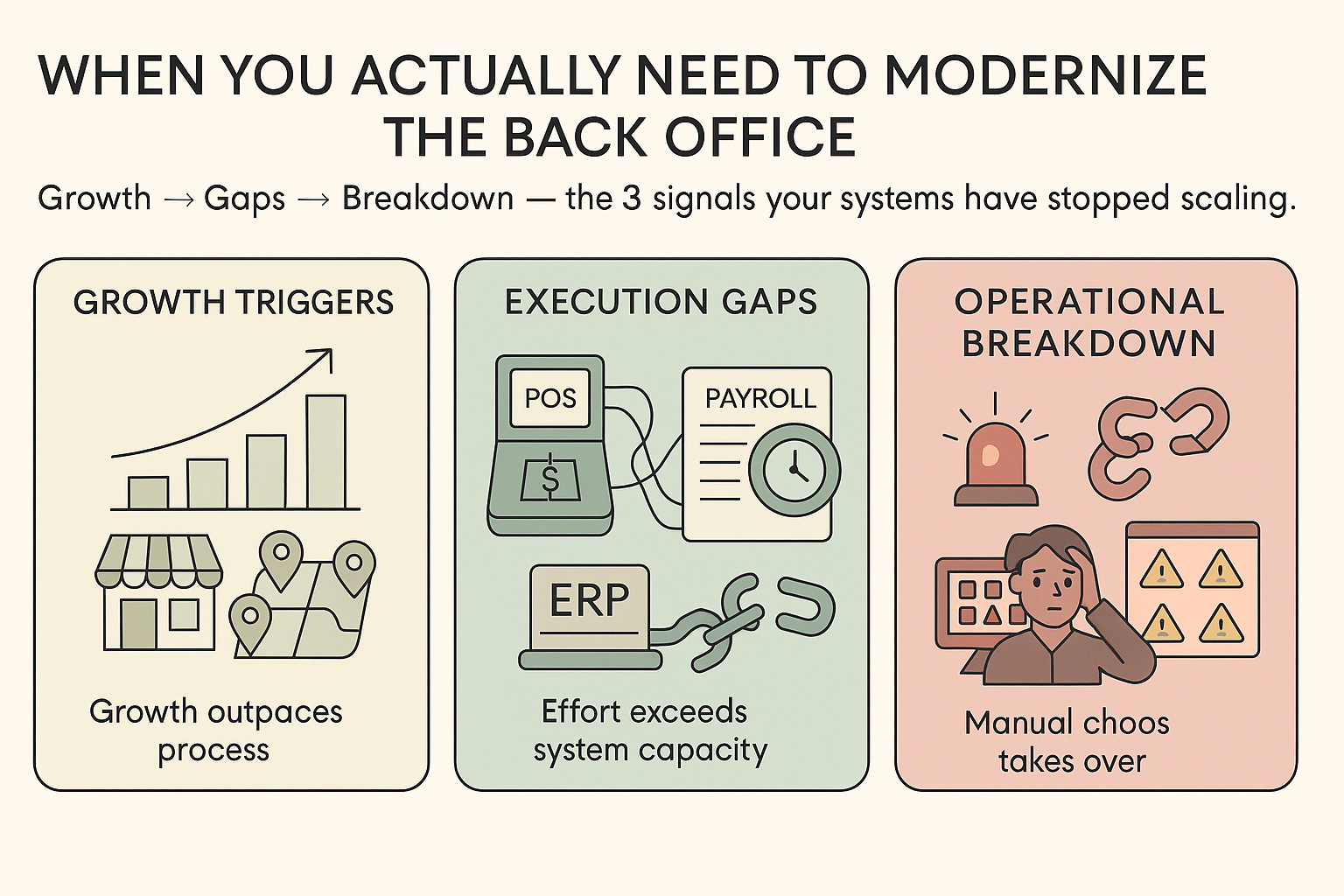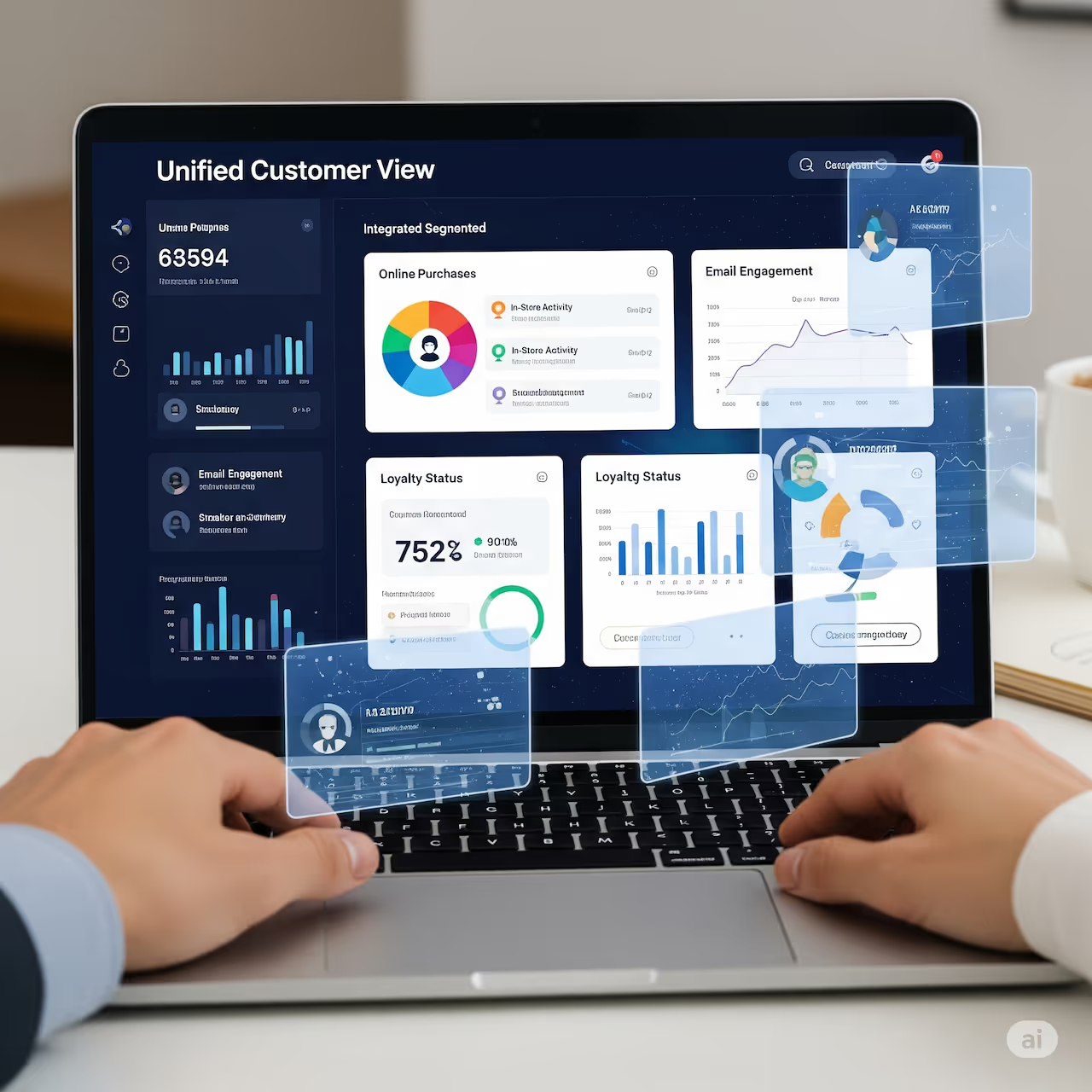TL;DR
The back office is retail’s hidden engine room. Six SaaS pillars—Finance, HR, Collaboration, Productivity, Security, and DevOps—replace spreadsheets and legacy systems with an integrated operating backbone. For retailers and brands scaling stores, staff, and channels, this stack means faster closes, predictable payroll, consistent execution, audit-ready compliance, and resilient IT. Without it, growth stalls under manual chaos.
Retail growth rarely fails at the checkout. More often than not, it fails in the back office.
The back office is where everything that keeps a retail business running quietly happens - payroll, reconciliations, scheduling, compliance, IT. When it works, no one notices. When it doesn’t, everything slows down.
Most retailers modernize where customers can see it: new POS systems, slicker eCommerce sites, redesigned loyalty programs. But behind the scenes, many still rely on spreadsheets, shared drives, and patchwork systems to run the actual business. That’s where operations begin to crack as the company scales.
A modern back office replaces that patchwork with a connected, cloud-based stack — automating core workflows across finance, HR, collaboration, and IT. It becomes the foundation for faster closes, predictable payroll, consistent communication, and audit-ready compliance.
At its core, the modern back office runs on six pillars: Finance & Accounting, Human Resources, Collaboration & Communication, Productivity Tools, Security & Compliance, and DevOps & IT Ops.
Whether you’re running a handful of stores or a regional network of hundreds, the back office is where scale either happens smoothly or breaks silently
If your finance team still closes books manually, HR can’t link labor costs to sales, collaboration lives across WhatsApp and inbox threads, security depends on shared passwords, and IT spends more time firefighting than improving - it’s time to modernize.
Why does it matter? Because unified commerce only scales if the back office underneath it is reliable, compliant, and connected across HQ, stores, and partners.

What Retailers Really Need in a Back Office Stack
A modern retail back office runs on six connected systems that replace spreadsheets and manual workflows with a reliable operating backbone. Each solves a different kind of complexity - from clean financials to secure infrastructure.
1. Finance & Accounting
The control tower for accuracy and compliance. One real-time view across stores, entities, and channels keeps decisions grounded in truth.
→ Shorter closes, cleaner audits, fewer surprises.
Key Vendors: Zoho Books, TallyPrime, QuickBooks Online, Xero, Oracle NetSuite ERP
2. Human Resources
Digitizes the full employee lifecycle — hiring, scheduling, payroll, and reviews — while keeping compliance in check.
→ Predictable labor costs, faster onboarding, stable teams.
Key Vendors: Darwinbox, Keka HR, BambooHR, Workday, PeopleStrong
3. Collaboration & Communication
Aligns HQ and stores with unified chat, video, file-sharing, and announcements.
→ Faster decisions, consistent execution.
Key Vendors: Slack, Microsoft Teams, Google Workspace, Zoom, Lark
4. Productivity Tools
Lightweight utilities for docs, tasks, and templates that make SOPs repeatable and accessible.
→ Higher consistency, less duplication, faster onboarding.
Key Vendors: Notion, ClickUp, Trello, Airtable, Zoho Workplace
5. Security & Compliance
Protects data, users, and systems with identity, access, and privacy controls baked into daily ops.
→ Lower risk, audit-ready evidence, stronger trust.
Key Vendors: Okta, Safe Security, Cloudflare, Palo Alto Networks Prisma Cloud
6. DevOps & IT Ops
Keeps technology stable and scalable — deploying, monitoring, and fixing fast.
→ Higher uptime, fewer failures, faster recovery.
Key Vendors: Jira Service Management, Freshservice, Datadog, GitLab, ManageEngine, ServiceNow
When You Actually Need to Modernize the Back Office
Not every retailer needs a full operating backbone from day one. But there’s a clear point where your current setup starts holding you back. The signs usually show up as growth triggers, execution gaps, or outright operational breakdowns.
If these patterns sound familiar, it’s time to move beyond spreadsheets and patchwork apps to a system that can scale with you.
Growth Triggers
- Stores expand beyond 5–10 and SKU counts explode, outpacing manual control.
- Expansion into new regions or entities adds tax and compliance complexity.
- Headcount climbs into the hundreds, making payroll and scheduling automation essential.
- Seasonal surges and new partners expose “temporary fixes” that start breaking permanently.
Execution Gaps
- Finance still runs on Excel for reconciliations and reporting.
- Payroll inaccuracies create dissatisfaction—or fines.
- IT teams spend more time firefighting integrations than improving systems.
- Schedule chaos, communication gaps, audit scrambles, and shadow tools multiply across teams.
Operational Breakdown
- Month-end close stretches into weeks, stalling decisions and blurring cash visibility.
- HR can’t link labor cost to sales, leaving staffing ROI in the dark.
- Rising compliance and security risks as disconnected systems widen your exposure.
- Inconsistent SOPs, duplicate truths, endless IT tickets, and creeping access drift.
If three or more of these signals sound familiar, you’ve likely hit the inflection point. At that stage, it’s no longer about patching gaps with extra spreadsheets or stopgap tools. You need a connected operating backbone—one that scales with growth, reduces daily firefighting, and builds the discipline to execute reliably across stores, staff, and systems.

How to Evaluate Back Office Capabilities
Choosing the right operating backbone isn’t about the longest feature list — it’s about whether a tool can scale with your growth, integrate cleanly into your stack, and keep you compliant without creating new headaches.
A strong evaluation lens covers four things for every pillar:
1️⃣ Core capabilities
2️⃣ Integration depth
3️⃣ Total cost of ownership (TCO)
4️⃣ Governance maturity
That’s what separates the systems that fit your operations from those that just look good in a demo.
1. Finance & Accounting
Your financial system should act as a single source of truth — not a patchwork of spreadsheets
Core capabilities: Real-time financial visibility, budgeting and forecasting, tax and entity handling, and month-end close automation.
Integrations: POS, OMS, eCommerce, payroll, and banking APIs for live reconciliation.
TCO lens: Check license tiers, migration and implementation fees, and API-based overages that inflate long-term cost.
Governance: Role-based access (RBAC), segregation of duties (SoD), and audit logs with SOC 2/ISO compliance.
Watch-outs: Batch posting delays, weak deferred revenue handling, and limited local tax coverage.
Ask vendors:
- How fast do POS and OMS events post to the ledger?
- Can we export journals and attachments in open formats if we churn?
2. HR & Payroll
Modern HR systems align people, payroll, and performance without creating admin drag.
Core capabilities: Fast onboarding, time & attendance sync, scheduling, payroll alignment, and compliance tracking.
Integrations: General Ledger, T&A devices, Store Ops tools, and SSO.
TCO lens: Understand PEPM (per-employee-per-month) pricing, rollout costs, and compliance add-ons as headcount scales.
Governance: Encryption, PII protection, and statutory archives.
Watch-outs: CSV-based syncs, limited in-country coverage, and hidden statutory fees.
Ask vendors:
- Do payroll and labor costs post automatically to the GL?
- Which countries have native compliance vs. partner handling?
3. Collaboration & Communication
The goal: one source of truth for updates, files, and discussions across HQ and stores.
Core capabilities: Unified chat, video, file-sharing, partner channels, and searchable knowledge.
Integrations: SSO, DLP, calendar, and task/project tools.
TCO lens: Include storage tiers, guest access, and archival pricing in your cost model.
Governance: Retention and discovery policies, guest access control, and role-based spaces.
Watch-outs: Shadow channels (e.g. WhatsApp), search chaos, and notification overload.
Ask vendors:
- How are HQ and store channels segmented but consistent?
- What eDiscovery and export options exist for compliance?
4. Productivity Tools
Everyday tools that keep the rhythm across departments.
Core capabilities: Docs, sheets, templates, checklists, kanbans, and lightweight automations.
Integrations: HR, finance, and collaboration tools for shared approvals.
TCO lens: Seat licenses and automation quotas can spike costs as adoption grows—model usage growth early.
Governance: Permissions, archival, backup, and export options.
Watch-outs: Poor version control, brittle automations, and unclear template ownership.
Ask vendors:
- Who owns templates and publishing rights?
- What’s the backup and export model if we switch vendors?
5. Security & Compliance
Security is the foundation, not an afterthought.
Core capabilities: SSO/MFA, device and network protection, threat detection, encryption, and centralized logging.
Integrations: Identity Provider (IdP), Endpoint Detection & Response (EDR), Security Information & Event Management (SIEM), Data Loss Prevention (DLP), and Ticketing/IT Service Management (ITSM)
TCO lens: Account for both user and endpoint licenses, SOC testing, and support retainers.
Governance: Least-privilege access, residency alignment, and incident SLAs.
Watch-outs: Over-privileged access, missing evidence trails, and alert fatigue.
Ask vendors:
- How is least-privilege enforced and logged?
- Can all access logs stream to our SIEM with immutable retention?
6. DevOps & IT Ops
The invisible engine that keeps tech stable, scalable, and secure.
Core capabilities: Incident/change management, CI/CD pipelines, monitoring, and observability.
Integrations: HRIS, SSO, POS, OMS, ERP, and cloud infrastructure.
TCO lens: Track per-agent, per-host, and per-GB monitoring fees that balloon as integrations scale.
Governance: Standardized change control, SLAs, and tested recovery runbooks.
Watch-outs: Tight rate limits, no event replay, and opaque SLAs.
Ask vendors:
- How is integration reliability measured (retries, replays, dead-letter queues)?
- What are the MTTR (Mean Time To Recovery) and SLA targets per severity level?
Your goal isn’t just to buy software. It’s to build an operating backbone that delivers discipline and reliability across finance, people, collaboration, security, and IT. Always push vendors beyond the demo deck: Ask about latency, audit trails, hidden fees, and exit readiness. If they hesitate or stay vague, that’s your red flag.
Strong back-office SaaS isn’t just a purchase, it’s long-term operational insurance.
Implementation Playbook: Build It, Don’t Bolt It On
Modernizing your back office isn’t a one-time rollout- it’s a sequence.
Each pillar builds on the previous one, creating a foundation that’s both stable and scalable.
- Sequence smartly: Anchor finance first → add HR & collaboration → layer productivity → harden security → standardize DevOps. Each phase stabilizes the next. Avoid deploying everything at once.
- Pilot small: Test in 1–2 stores or functions with clear KPIs. Prove value before scaling.
- Scale only when outcomes hold: Close ≤5 days, payroll error rate <1%, and uptime ≥99.9%. Expand once benchmarks are met
- Guardrails: Shared taxonomy, role-based access, integration observability, and documented SOPs. These small disciplines make scaling predictable.
.png)
Your Operating Backbone Decides If Strategy Scales
A modern operating backbone isn't overhead. It's the engine behind your growth. Done right, it turns strategy into consistent execution across finance, HR, collaboration, productivity, security, and IT. That discipline is what makes unified commerce deliver in the real world: clean handoffs, reliable numbers, fewer fires.
The only questions left are timing and approach - when you switch it on, and how you roll it out without breaking rhythm.
Next Steps
- Audit pain points per pillar. Define 2–3 outcomes per pillar.
- Map growth triggers: store expansion, staff scale, and new regions.
- Shortlist SaaS vendors that meet integration, compliance, and scalability needs.
- Pressure-test vendors with integration and compliance questions.
- Pilot with clear exit criteria. Scale only after the KPIs hold.
Start small, measure hard, and scale only what proves out, so your operating backbone grows with the business without cracks.
.webp)

.avif)


.avif)